IDEX Online Research: April Jewelry Sales Continue to Show Moderate Gains in U.S. Market
July 01, 08
We hear nothing but tales of woe from U.S. merchants in the jewelry business. But for the second month in a row, the U.S. government figures show that specialty jewelers’ sales rose by almost 4 percent. For the first fiscal quarter, the government’s Department of Commerce says total specialty jewelers’ sales rose by 3.4 percent. While these figures aren’t robust, they aren’t a disaster, either.
Total jewelry sales by all merchants – specialty jewelers and multi-line retailers – were up a strong 5.9 percent in April, well ahead of total retail sales gains. In other words, jewelry gained a small share of wallet in the month, but those sales were made primarily by multi-line retailers rather than specialty jewelers.
The following is a summary of April retail sales results for both jewelry and other categories of retail:
- +5.9 percent - Total U.S. Jewelry Sales
- +3.9 percent - Total U.S. Specialty Jewelers’ Sales
- +3.7 percent - Total U.S. Retail Sales (All Categories)
- +5.7 percent - Total U.S. Retail Sales (Ex-Auto & Food)
The table below summarizes retail sales trends for the past three months in the U.S. market.
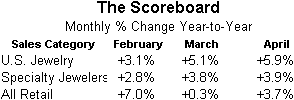
Source: Various
Who is posting big sales gains, and who is trailing? The table below summarizes reported first quarter total sales gains for most of the major publicly held jewelers for their U.S. operations as well as our estimates of adjustments to make them comparable year-to-year. Further, same-store sales are shown on the table.

Source: Company Reports
Outlook Cautious; Forecast Unchanged
Our outlook for U.S. jewelry sales remains cautious for the first half of the year. Whether or not we are in a “technical recession” – defined as two consecutive quarters of a decline in Gross Domestic Product – or just in a “mental recession” with consumers tightening their purse strings, the fact is this: retail spending has slowed notably.
Last month, we raised our full year jewelry sales forecast to +3 percent from our prior forecast of +1-2 percent (point estimate was about +1.4 percent). Why? Jewelry price inflation at the retail level is running rampant. That alone will push up “reported” sales. We continue to believe that unit sales of jewelry will be down in 2008, perhaps in the low to mid-single digit range.
April Jewelry Sales Show Mid-Single Digit Gain
The total market for jewelry in the U.S. grew by a very strong 5.9 percent rate during April. Specialty jewelers in the U.S. market posted a solid sales gain of 3.9 percent over the same month a year ago, about in line with last month’s adjusted sales increase. Unfortunately, though, these figures confirm that specialty jewelers lost market share in April versus their competition from non-traditional sources of jewelry such as discounters, mass marketers, and others.
However, the jewelry industry gained market share when compared to other retail categories. Total retail sales (all goods, including food and automobiles), were up – +3.7 percent – in April. Specialty jewelers, which as a group generated a +3.9 percent sales gain, gain market share from other categories of retailing, but lost market share to other specialty merchants, whose sales were up by 5.7 percent. Specialty merchants include all retailers except automobile and food retailers. Frankly, it is a surprise – though a pleasant surprise – that jewelry sales were so robust in April. There is no calendar sales event (such as Valentine’s) which drives demand in April.
The graph below compares specialty jewelers’ sales trends (red line) to total jewelry sales trends (blue line) in the U.S. market. As the graph clearly illustrates, jewelry sales at specialty jewelers have been on a roller coaster ride for the past few months, with a sharp slide in September, a spike in October, another slide in November and December, followed by a modest recovery in January, a dip in February, and another recovery in March which continues into April. However, since the beginning of the year, specialty jewelers lost just a little market share from multi-line merchants who sell jewelry, based on recently revised government figures.
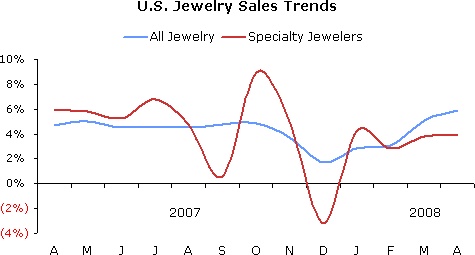
Source: US Dept. of Commerce
The graph below summarizes sales trends for all retail goods (green line) excluding food and automobiles versus specialty jewelers’ sales (red line). When food and auto sales are excluded, the remaining retail categories posted a sales gain of 5.7 percent in March. When food and auto sales are included, retail sales were up 3.7 percent for the month, as previously indicated.
Why do we eliminate “automobile” sales? Monthly auto sales are driven largely by consumer incentives rather than by underlying economic factors. Over the long term, auto demand trends are an important indicator of consumer vitality; however, on a month-to-month basis, auto demand is dependent on manufacturers’ incentives such as zero percent financing, cash-back offers and other deals. Food sales are far less cyclical and can mask changes in consumer demand; thus, we eliminate them, too.
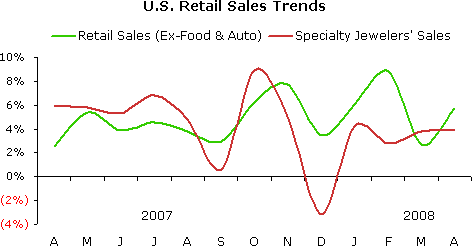
Source: US Dept. of Commerce
Consumer Spending Slowed Again in April
Driven by price inflation of core commodities such as gasoline and food, consumer expenditures rose by 4.6 percent during April 2008. In March, we had seen a hopeful modest uptick in consumer spending. However, when consumer spending trends are viewed over the past several months, the trend is decidedly slowing (black line on graph below). Spending on services remains more-or-less on track, with little monthly deviation.
The graph below summarizes trends in American’s total spending (black line), retail sales of all goods (blue line) and expenditures on jewelry (red line). It is clear that dismal automobile sales in the U.S. market are having a dramatic negative impact on total retail sales (blue line). Automobile sales in 2007 were just over 20 percent of total retail sales; thus, it is clear why they have such an impact on total retail sales trends. And, it should be obvious why we typically eliminate them, when we analyze U.S. retail sales. Automobile sales are driven largely by the “deal-of-the-day,” as we noted above.
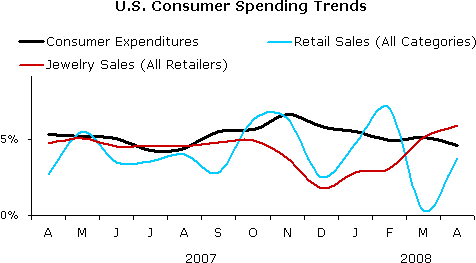
Source: US Dept. of Commerce
First Quarter Sales Trends by Publicly Held Jewelers
Just as the jewelry industry suffered from slowing spending on gemstones and precious metals, the publicly held jewelers also experienced tough sales comparisons. Time after time, management of these companies talked about “the tough retail environment.”
Here’s what they said sold in the first quarter – it is essentially the same list that we published last month:
- Branded jewelry
- Fashion jewelry
- Designer name jewelry
- Unique jewelry
- Custom-made jewelry
Bread-and-butter commodity jewelry remains weak. The only category that continues to show consistently solid demand is bridal. However, we are seeing a trend toward smaller solitaire rings as well as wedding bands with diamonds in lieu of the traditional engagement solitaire.
The following graph summarizes their first quarter total sales gains (blue bar) as well as our adjustments (red bars) to try to make level the playing field for comparative purposes.
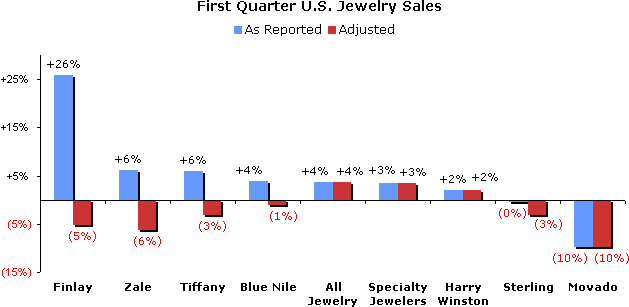
Source: Company Reports
- Finlay’s first quarter sales were driven by an incremental $50 million from its specialty store division – mostly from the acquired Bailey Banks & Biddle stores. It is not entirely correct to remove this total amount without making some other minor adjustments, but the effect would have been that this year’s sales would have been below last year by an estimated 5 percent or so.
- Zale ran blow-out inventory liquidation sales in the first quarter. If the incremental liquidation sales had been removed (note: we are only removing liquidation sales above the norm of the past several years, since Zale, like most jewelers, is always running some level of liquidation sales – generally about 8-10 percent of sales), Zale’s first quarter sales would have been down by about 6 percent.
- Tiffany’s sales gains were driven almost entirely by overseas tourists spending heavily on jewelry in U.S. Tiffany stores. Same-store sales in Tiffany’s branches were down 4 percent.
- Blue Nile reported that its total sales were up 3.8 percent in the first quarter ended March. However, all of that gain came from international markets; sales to U.S. customers were down about 1 percent, as indicated by the graph.
- Sterling’s sales were boosted by higher retail prices. We estimate that those higher retail prices helped boost total sales by about 3 percent in the quarter.
- Movado’s retail operations are suffering while the company attempts to find new leadership for that division; it is also remerchandising its stores. The Movado Boutiques – a full price operation – posted much weaker sales – down 15.7 percent – than the Movado Outlets – down 1.9 percent.
- Harry Winston did not provide enough information for us to make an intelligent estimate of adjustments that might be needed to make its sales comparable.
2008 Jewelry Sales Forecast Unchanged
While the economy is not technically in a recession – first quarter economic growth was anemic, but still slightly positive – consumers are in a mental recession. As a result, jewelry demand is soft.
But there is something else going on that we haven’t seen in more than a decade: rampant inflation in the jewelry industry. Precious metals prices have risen steeply and those higher costs are finally finding their way though to retail prices. During March and April, retail jewelry prices in the U.S. market were up in sharply. In May and early June, we saw even more jewelry price increases at retail.
As a result of inflationary pressures, our jewelry sales forecast for the U.S. calls for a +3 percent gain for 2008. It is likely that specialty jewelers will report sales in excess of this gain, while multi-line retailers who sell jewelry will likely experience smaller gains, though current trends would suggest otherwise. There is one important note: all jewelers are expected to sell fewer pieces of jewelry (if inflation remains in the 8-9 percent range, it means that unit sales of jewelry will be down 5 percent or so); further, we are assuming that the average ticket doesn’t move much.
Finally, we are expecting customer traffic to be down modestly, but the conversion rate should rise. Why will the conversion rate rise? If jewelers help their sales people do their job, fewer browsers will walk away without buying anything.